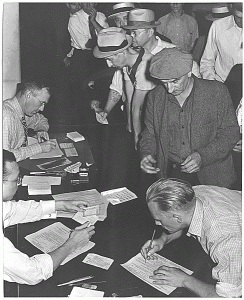
In the spring of 1932, in Compton, California, an unemployed World War I veteran walked out to the farms that still ringed Los Angeles. He offered his labor in return for a sack of vegetables, and that evening he returned with more than his family needed. The next day a neighbor went out with him to the fields. Within two months 500 families were members of the Unemployed Cooperative Relief Organization.
That group became one of 45 units in an organization that served the needs of some 150,000 people.
It operated a large warehouse, a distribution center, a gas and service station, a refrigeration facility, a sewing shop, a shoe shop, even medical services, all on cooperative principles. Members were expected to work two days a week, and benefits were allocated according to need. A member with a wife and two kids got four times as much food as someone living alone. The organization was run democratically, and social support was as important as material support. Members helped one another resist evictions; sometimes they moved a family back in after a landlord had put them out. Unemployed utility workers turned on gas and electricity for families that had been cut off.
Read the rest at YES! Magazine
Go to the GEO front page

Add new comment